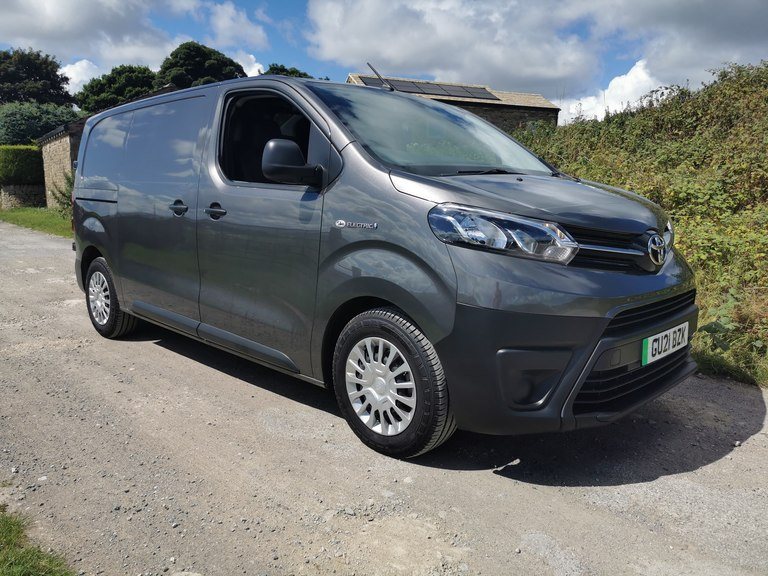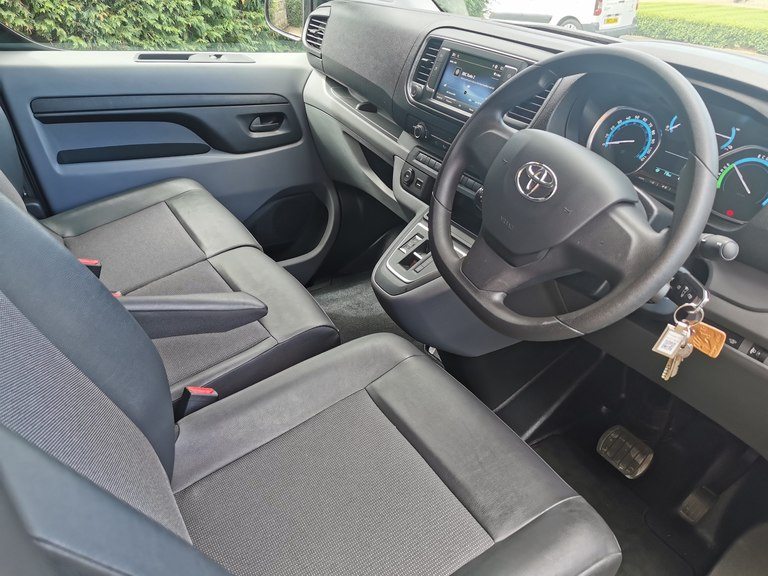Electric Vans / Electric Van Reviews / Toyota Proace Electric
The huge Stellantis group (formerly known as PSA) has achieved massive success with its medium electric van offering under the Vauxhall, Peugeot, Citroen and now Fiat brands. But, due to a commercial agreement, the van is also available with a Toyota badge. Our Van Expert Tim Cattlin spent a week with one to see why these vans are so popular…
The ever-popular medium van sector is hotly fought over by competing manufacturers, so with our eventual transition to zero-emission van operation, it’s not surprising that we’re seeing some cracking electric products being announced. But with the electric version of the top selling Ford Transit Custom yet to arrive in the showrooms at the time of writing, so far, the offerings from Stellantis have been relatively untroubled.



Although the Proace is available in a choice of two lengths in diesel form, those opting for the Electric will have to be satisfied with the Medium, the shorter of the two variants, and there’s just a standard roof height. Looks are subjective and whilst the Proace is unlikely to turn many heads as it passes, Toyota has managed to make the van look smart, especially from the front aspect. The lines are clean, smooth and uncluttered – there are no pretensions but that doesn’t make it look bland in any way. At first glance you’d be forgiven for assuming the wheels are alloy – they’re not but the trims are an excellent imitation.
Twin side loading doors in addition to the twin rear doors make for easy access to the loadspace which measures a competitive 2413mm in length. Combined with a width of 1636mm and height of 1397mm, there’s a volume of 5.3 cubic metres on offer. Naturally, there’s a full height bulkhead but it has a glazed section which doesn’t serve much purpose in a van with solid rear doors.
Payload is up to 1200kgs with the smaller of the two battery pack options (reduced to a still very creditable 1000kg with the larger pack) which is an excellent achievement given the weight of the battery and drivetrain. In addition, a 1000kg towing capacity is better than other larger electric vans and the Proace even comes with a trailer electrical connector as standard.
With recent launches of electric vans having some very powerful electric motors, the 136hp unit fitted to the Proace Electric might sound a little modest, but that’s not the case in practice, more on which later. The test van had the 75kWh battery, but operators are given the choice between maximum payload or range with the availability of a 50kWh pack. With this higher rated option, the official WLTP Combined test cycle range is an excellent 205 miles, although the usual caveat applies that this figure should be used for comparison purposes only, real world conditions eating into the figure to a lesser or greater degree. To keep this range optimised, Toyota has restricted the van to an 80mph top speed, and it accelerates from 0-60mph in around 13.4 seconds (12 seconds in the Proace with the lighter, smaller battery pack). As with many electric vans, there are three available drive modes. Normal restricts the power to 109hp whereas Eco drops it to 82hp, both options designed to conserve range. Only Sport mode provides unrestricted power from the motor.
Plug the van with the 75kWh battery into your 7.4kWh home AC wallbox and you’ll get back to 100% in around 11 hours and depending on the DC charge rate, you could be back up to 80% in as little as 48 minutes from a public chargepoint.
There are a couple of things to mention here. Firstly, to me, the cab feels smaller than some competitor medium vans and with two passengers alongside the driver, it can feel cramped. How it measures up in reality may well disprove this comparison but, it doesn’t take away the sensation that it’s on the small side for a medium van. Secondly, other reviewers have commented on an awkward driving position due to the pedals being offset to one side causing aches on long journeys. I’ve driven a number of these vans and have never noticed this aspect but, a prospective buyer might be advised to at least sit in a van before committing. There’s not a huge amount of storage space but achieving this is always tricky for designers of anything but a large van. Other than that, the cab is perhaps nothing special and maybe slightly dated but, otherwise functional.
The instrument panel is simple but effective in its design. Alongside the speedometer, a large gauge shows the amount of power being used, of the level of regeneration, or recuperation being gained. A meter similar to a fuel gauge provides a visual indication of the charge remaining, and there’s a digital readout of the range left, which I found to be more accurate than others I’ve encountered.
There’s only a single trim, or grade, for the Proace Electric, the Icon coming with a 7” multimedia screen incorporating Apple and Android smartphone integration, air conditioning, cruise control and rear parking sensors.
The drive selector is where, in my opinion, it should be, where the gear lever would otherwise be located. Despite the relatively modest power available acceleration to 30mph is very rapid, presumably due to the instant availability of torque from the electric motor. From then on, progress is steady but the van had no trouble in maintaining the 80mph top speed even on gradients (although it was unladen).
In an urban environment, the van handled very well, the steering inspiring confidence, and even unladen the ride quality was more than acceptable. There was very little noise or vibration, the overall impression being that the Proace Electric offered a refined driving experience.
It’s not surprising that this van (and others sharing the platform) sells well. Range and performance are acceptable and competitive, its load carrying credentials are good, it drives well and looks OK too. In addition, Toyota comes to the party with the warranty. As long as you get it serviced at a Toyota dealer, you’ll have cover for 10 years or 100,000 miles alongside the standard 8 years or 62,000 miles of cover for the battery capacity.
As electric medium vans go, there’s probably little to beat it, for the time being at least…